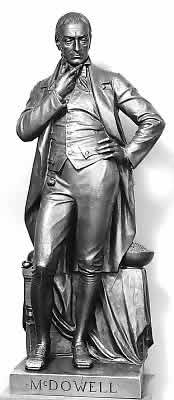<Back to Index>
- Physician Ephraim McDowell, 1771
- Novelist Fyodor Mikhaylovich Dostoyevsky, 1821
- King of Italy Victor Emmanuel III, 1869
PAGE SPONSOR

Ephraim McDowell (November 11, 1771 – June 25, 1830) was an American physician. He was the first to successfully remove an ovarian tumor.
Ephraim McDowell was born in Rockbridge County, Virginia, the ninth child of Samuel and Mary McDowell. His father was a veteran of the French and Indian War and a colonel during the American Revolution. In 1784 Samuel McDowell was appointed land commissioner and moved his family to Danville, Kentucky. There, he presided over ten conventions that resulted in the drafting of the Kentucky Constitution. Ephraim McDowell received his early education at the classical seminary of Worley and James, then spent three years as a medical student under Dr. Alexander Humphreys in Staunton, Virginia. He attended lectures in medicine at the University of Edinburgh, Scotland, from 1793 to 1794 and studied privately with John Bell. He never received a diploma, but in 1825, the University of Maryland conferred on him an honorary M.D. degree.
In 1795, he returned from Scotland, settled in Danville, Kentucky, and began his practice as a surgeon. In 1802, he married Sarah Shelby, daughter of Isaac Shelby, war hero and twice governor of Kentucky. They had two sons and four daughters. Dr. McDowell played a prominent role in his community. He was a founder of Trinity Episcopal Church in Danville, donating the land for its first building. He was also a founder, original corporator, and member of the primary board of trustees of Centre College in Danville. Dr. McDowell became a member of the Philadelphia Medical Society in 1817. One of his most famous patients was James K. Polk, for whom he removed a urinary stone and repaired a hernia. Dr. McDowell was the great great grandfather of General John Campbell Greenway, whose statue was placed in the National Statuary Hall Collection by the state of Arizona in 1930. He was cousin to woman's suffrage leader Madeline McDowell Breckinridge.
In
June 1830 Dr. McDowell was stricken with an acute attack of violent
pain, nausea, and fever. He died on June 25, most likely a victim of appendicitis. His
wife died 18 years later. They were buried at "Traveller's Rest" the
homestead of Isaac Shelby south of Danville, but reinterred in 1879
near a monument dedicated to him in Danville. On December 13, 1809, Dr. McDowell was called to see Jane Todd Crawford in Green County, Kentucky,
60 miles (97 km) from Danville. Her physicians thought that
Mrs. Crawford was beyond term pregnant. Dr. McDowell diagnosed an
ovarian tumor. She begged him to keep her from a slow and painful
death. He then described her condition and that an operation for cure
had never been performed. He said that the best surgeons in the world
thought it impossible. Mrs. Crawford said she understood and wanted to
proceed. Dr. McDowell told her he would remove the tumor if she would
travel to his home in Danville. She agreed and rode the sixty miles on
horseback. On
Christmas morning, 1809, Dr. McDowell began his operation. The surgery
was performed without benefit of anesthetic or antisepsis, neither of
which was then known to the medical profession. The tumor Dr. McDowell
removed weighed 22.5 pounds (10.2 kg). He determined that it
would be difficult to remove it completely. So he tied a ligature around the fallopian tube near the uterus and
cut open the tumor. He described the tumor as the ovarium and fimbrious
part of the fallopian tube very much enlarged. The whole procedure took
25 minutes. Mrs. Crawford made an uncomplicated recovery. She returned
to her home in Green County 25 days after the operation and lived
another 32 years. This was the first successful removal of an ovarian tumor in the world. All attempts at abdominal exploration before 1809 had resulted in peritonitis and
death. So, understanding the procedures taken by Dr. McDowell is
important. Descriptions of McDowell include phrases like "neat and
clean" or "scrupulously clean." He was not only neat, but meticulous.
In his report on the operation, he described the removal of blood from
the peritoneal cavity and bathing the intestines with warm water. Dr.
McDowell did not publish a description of his procedure until 1817,
after he had performed two more such operations. This was widely
criticised in the English surgical literature. There is evidence that
he performed at least twelve operations for ovarian pathology. "Having
never seen so large a substance extracted, nor heard of an attempt, or
success attending any operation such as this required, I gave to the
unhappy woman information of her dangerous situation. The tumor
appeared full in view, but was so large we could not take it away
entire. We took out fifteen pounds of a dirty, gelatinous looking
substance. After which we cut through the fallopian tube, and extracted
the sac, which weighed seven pounds and one half. In five days I
visited her, and much to my astonishment found her making up her bed."